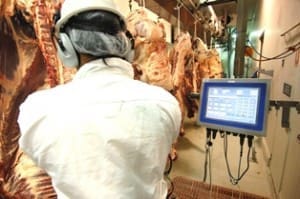PREDICTIONS that last week’s Eastern States kill might descend into record territory have proved true enough, with the big impact of heavy rainfall and flooding in some areas dragging numbers back dramatically.
The National Livestock Reporting Service logged a seven-day kill for the week ended Friday of just 104,490 head – perhaps unprecedented for a September week in the Australian beef industry.
 The rain impact, thrown on top of the underlying shortage of cattle after two big drought years, has forced beef plants across much of Eastern Australia into skeleton kills, with numerous reports this week of three-day and even two-day rosters in place.
The rain impact, thrown on top of the underlying shortage of cattle after two big drought years, has forced beef plants across much of Eastern Australia into skeleton kills, with numerous reports this week of three-day and even two-day rosters in place.
Queensland was hit hard last week, with a tally of just 53,700 head – down an cavernous 31 percent on this week last year.
Worth noting, also was the size of the female kill in Queensland last week. With just 18,411 cows and heifers processed for the seven-day cycle, females represented just 34 percent of the state’s throughput – as low as has been seen in recent memory.
New South Wales was almost as badly affected, logging 25,700 head processed last week, a year-on-year fall in numbers of 30pc, while Victoria fell 26pc to 18,500 head. In South Australia, plant closures saw numbers back 67pc to just 2984 head, while in Tasmania, the kill actually lifted 2pc on the previous week to 3497 head.
While conditions have fined-up substantially this week, there is still some hangover evident, with a lot of plants spoken to this morning again reducing schedules to compensate. Wagga and other sales held early this week have shown some signs of rebuilding numbers after the wet, but it’s still work in progress in many centres, it appears.
No movement in grids
There’s been no significant change in direct consignment grid offers this week for kills at southern Queensland plants before the end of September.
Current offers, now unchanged for five weeks, have four-tooth grassfed ox at 560-570c/kg, depending on location and transport advantage, and heavy cows 510-520c/kg. Take 10c off that for Central Queensland kills, and another 10c in northern regions of the state.
Northern NSW grids have heavy full-mouth cows top cell this week at 500c/kg and four-tooth steer (HGP-free) at 565c/kg.
While there have been numerous predictions that slaughter cattle prices might start to slide once the weather disruption factor is cleared, it has not happened yet – but may now be drawing close if numbers start to rise a little heading into October, as has been forecast earlier.
With typical processor losses of 70-100c/kg on slaughter cattle being killed currently, plants may in fact be reluctant to ramp-up kills at current grid rates, even if the cattle were there.
But in response, a couple of sudden 10c/kg checks in the market to try to neutralise some of the processor losses being logged on export slaughter cattle could well stimulate a flush of livestock bookings, as producers seek to secure prices as close as possible to the top of the market.
Currently, there is no real incentive to move, however, as cattle are gaining weight in oats and grass paddocks at a rapid rate, and the slaughter market in Queensland shows no sign of easing, just yet.
